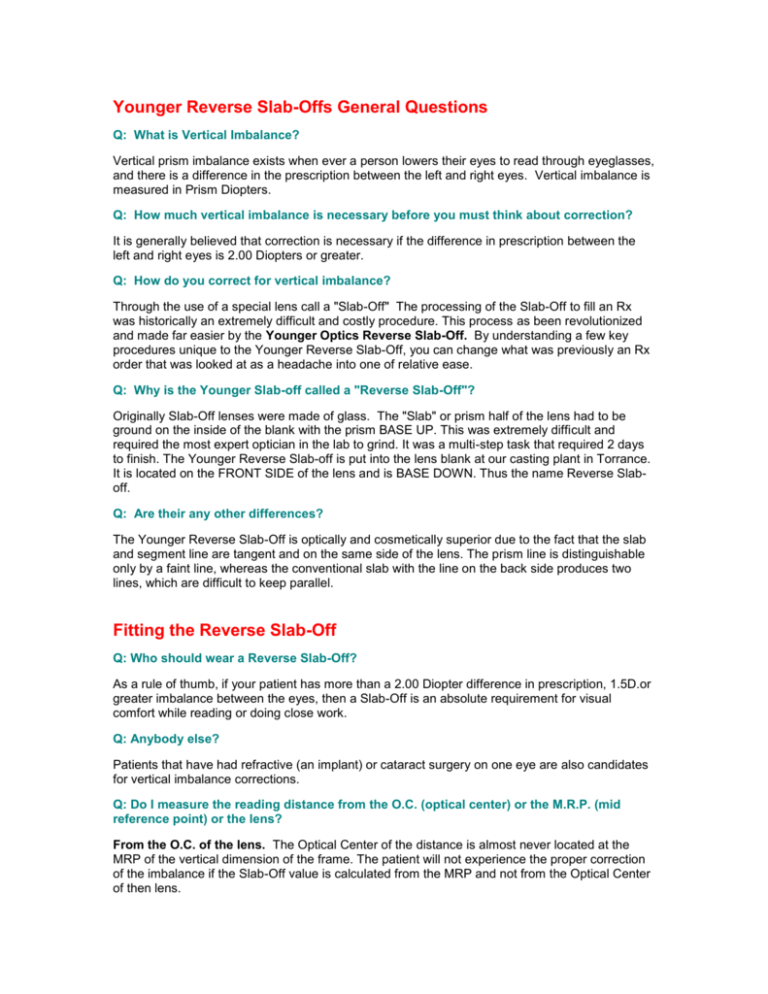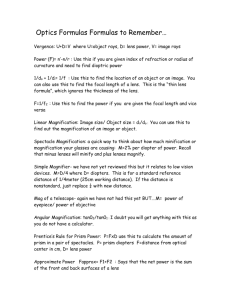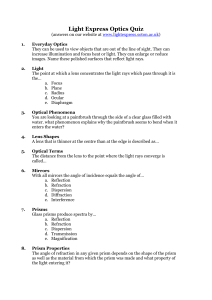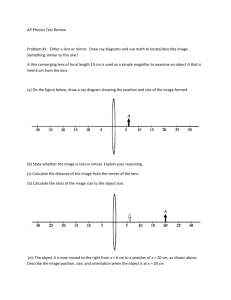Younger Reverse Slab-Offs General Questions
advertisement

Younger Reverse Slab-Offs General Questions Q: What is Vertical Imbalance? Vertical prism imbalance exists when ever a person lowers their eyes to read through eyeglasses, and there is a difference in the prescription between the left and right eyes. Vertical imbalance is measured in Prism Diopters. Q: How much vertical imbalance is necessary before you must think about correction? It is generally believed that correction is necessary if the difference in prescription between the left and right eyes is 2.00 Diopters or greater. Q: How do you correct for vertical imbalance? Through the use of a special lens call a "Slab-Off" The processing of the Slab-Off to fill an Rx was historically an extremely difficult and costly procedure. This process as been revolutionized and made far easier by the Younger Optics Reverse Slab-Off. By understanding a few key procedures unique to the Younger Reverse Slab-Off, you can change what was previously an Rx order that was looked at as a headache into one of relative ease. Q: Why is the Younger Slab-off called a "Reverse Slab-Off"? Originally Slab-Off lenses were made of glass. The "Slab" or prism half of the lens had to be ground on the inside of the blank with the prism BASE UP. This was extremely difficult and required the most expert optician in the lab to grind. It was a multi-step task that required 2 days to finish. The Younger Reverse Slab-off is put into the lens blank at our casting plant in Torrance. It is located on the FRONT SIDE of the lens and is BASE DOWN. Thus the name Reverse Slaboff. Q: Are their any other differences? The Younger Reverse Slab-Off is optically and cosmetically superior due to the fact that the slab and segment line are tangent and on the same side of the lens. The prism line is distinguishable only by a faint line, whereas the conventional slab with the line on the back side produces two lines, which are difficult to keep parallel. Fitting the Reverse Slab-Off Q: Who should wear a Reverse Slab-Off? As a rule of thumb, if your patient has more than a 2.00 Diopter difference in prescription, 1.5D.or greater imbalance between the eyes, then a Slab-Off is an absolute requirement for visual comfort while reading or doing close work. Q: Anybody else? Patients that have had refractive (an implant) or cataract surgery on one eye are also candidates for vertical imbalance corrections. Q: Do I measure the reading distance from the O.C. (optical center) or the M.R.P. (mid reference point) or the lens? From the O.C. of the lens. The Optical Center of the distance is almost never located at the MRP of the vertical dimension of the frame. The patient will not experience the proper correction of the imbalance if the Slab-Off value is calculated from the MRP and not from the Optical Center of then lens. Rules for Selecting the Proper Eye Q: How do is select the proper eye for the Reverse Slab-Off fitting? Rules for Selecting the proper eye: If both eyes are plus: Select the strongest plus. If both eyes are minus: Select the weakest minus. If one eye is plus and the other minus: Select the plus. Laboratory Questions Q: What does the laboratory need to know about the lens design? Only that the Reverse Slab-Off must be looked at as if it was two lenses, one above slab line and another below it. The reason being that the two areas (even though they are on the same curve) are at an angle to one another and need to be treated as if the lens was a two piece bifocal. Q: How does the lab avoid unwanted prism? All referencing must be from the distance portion (the area above the slab line). If this is not done, there will be unwanted prism in the distance which will alter the Reverse Slab-Off prism value. Simply ensure that the area above the slab line is a common center with the centerline of the generator chuck and parallel to the chuck face (prism free) Q: Other than avoiding unwanted prism are there any other special processing procedures? No, process exactly as you would any other hard resin lens. Q: What about final inspection? You must first MARK & READ the Distance Optical Center in both the right and left lenses. The Power and Position of the prism if prescribed, must match. Next, check the non slab eye in the focimeter at a point 5mm below the segment line in the bifocal area. Note the amount and direction of the prism. There will always be a certain amount of prism at this position in any flat top segment. Next place the Reverse Slab-Off in the same position - 5mm below the segment line. You should read an equal amount of prism in the same direction (as in the no slab eye) +/- 0.5 prism diopters, providing the distance optical center placement is correct. Tinting Questions Q: Can I tint a Slab-Off Lens? Yes, treat them as you would any other Hard Resin Lens. BONUS FEATURE Q: Is there another use for the Reverse Slab-Off? Generally Reverse Slab-Off BASE DOWN PRISM usage is thought of only when there is a difference of 2.00 Diopters or greater in the distance, to correct for vertical imbalance. An additional Reverse Slab application would be when vertical prism is called for in the distance RX creating an imbalance at the reading level (Rx distance prism when surfaced in, remains throughout the lens even at the reading level). Since the Reverse Slab Base Down Prism value starts at the segment line and is base down, when calculated for use properly can be used to neutralize or balance out the induced prism from the distance RX at the reading level.








